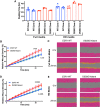Estrogen-independent molecular actions of mutant estrogen receptor 1 in endometrial cancer
- PMID: 31362937
- PMCID: PMC6724674
- DOI: 10.1101/gr.244780.118
Estrogen-independent molecular actions of mutant estrogen receptor 1 in endometrial cancer
Abstract
Estrogen receptor 1 (ESR1) mutations have been identified in hormone therapy-resistant breast cancer and primary endometrial cancer. Analyses in breast cancer suggest that mutant ESR1 exhibits estrogen-independent activity. In endometrial cancer, ESR1 mutations are associated with worse outcomes and less obesity, however, experimental investigation of these mutations has not been performed. Using a unique CRISPR/Cas9 strategy, we introduced the D538G mutation, a common endometrial cancer mutation that alters the ligand binding domain of ESR1, while epitope tagging the endogenous locus. We discovered estrogen-independent mutant ESR1 genomic binding that is significantly altered from wild-type ESR1. The D538G mutation impacted expression, including a large set of nonestrogen-regulated genes, and chromatin accessibility, with most affected loci bound by mutant ESR1. Mutant ESR1 is distinct from constitutive ESR1 activity because mutant-specific changes are not recapitulated with prolonged estrogen exposure. Overall, the D538G mutant ESR1 confers estrogen-independent activity while causing additional regulatory changes in endometrial cancer cells that are distinct from breast cancer cells.
© 2019 Blanchard et al.; Published by Cold Spring Harbor Laboratory Press.
Figures






Similar articles
-
Mutation site and context dependent effects of ESR1 mutation in genome-edited breast cancer cell models.Breast Cancer Res. 2017 May 23;19(1):60. doi: 10.1186/s13058-017-0851-4. Breast Cancer Res. 2017. PMID: 28535794 Free PMC article.
-
Allele-Specific Gene Regulation, Phenotypes, and Therapeutic Vulnerabilities in Estrogen Receptor Alpha-Mutant Endometrial Cancer.Mol Cancer Res. 2023 Oct 2;21(10):1023-1036. doi: 10.1158/1541-7786.MCR-22-0848. Mol Cancer Res. 2023. PMID: 37363949
-
Upregulation of IRS1 Enhances IGF1 Response in Y537S and D538G ESR1 Mutant Breast Cancer Cells.Endocrinology. 2018 Jan 1;159(1):285-296. doi: 10.1210/en.2017-00693. Endocrinology. 2018. PMID: 29029116 Free PMC article.
-
Targeted degradation of activating estrogen receptor α ligand-binding domain mutations in human breast cancer.Breast Cancer Res Treat. 2020 Apr;180(3):611-622. doi: 10.1007/s10549-020-05564-y. Epub 2020 Feb 17. Breast Cancer Res Treat. 2020. PMID: 32067153
-
ESR1 mutations in breast cancer.Cancer. 2019 Nov 1;125(21):3714-3728. doi: 10.1002/cncr.32345. Epub 2019 Jul 18. Cancer. 2019. PMID: 31318440 Free PMC article. Review.
Cited by
-
Small Molecular Inhibitors Reverse Cancer Metastasis by Blockading Oncogenic PITPNM3.Adv Sci (Weinh). 2022 Dec;9(35):e2204649. doi: 10.1002/advs.202204649. Epub 2022 Oct 26. Adv Sci (Weinh). 2022. PMID: 36285700 Free PMC article.
-
Estrogen receptor alpha mutations regulate gene expression and cell growth in breast cancer through microRNAs.NAR Cancer. 2023 Jun 1;5(2):zcad027. doi: 10.1093/narcan/zcad027. eCollection 2023 Jun. NAR Cancer. 2023. PMID: 37275275 Free PMC article.
-
Clinical Application of Next-Generation Sequencing for Molecular Classification in the Management of Endometrial Cancer: An Observational Cohort Study.Cancers (Basel). 2025 May 28;17(11):1806. doi: 10.3390/cancers17111806. Cancers (Basel). 2025. PMID: 40507285 Free PMC article.
-
Estrogen Receptor Function: Impact on the Human Endometrium.Front Endocrinol (Lausanne). 2022 Feb 28;13:827724. doi: 10.3389/fendo.2022.827724. eCollection 2022. Front Endocrinol (Lausanne). 2022. PMID: 35295981 Free PMC article. Review.
-
ESR1 hotspot mutations in endometrial stromal sarcoma with high-grade transformation and endocrine treatment.Mod Pathol. 2022 Jul;35(7):972-978. doi: 10.1038/s41379-021-01003-5. Epub 2021 Dec 27. Mod Pathol. 2022. PMID: 34961764 Free PMC article.
References
Publication types
MeSH terms
Substances
Grants and funding
LinkOut - more resources
Full Text Sources
Molecular Biology Databases
Research Materials
Miscellaneous
